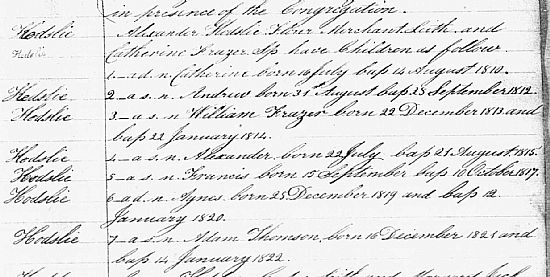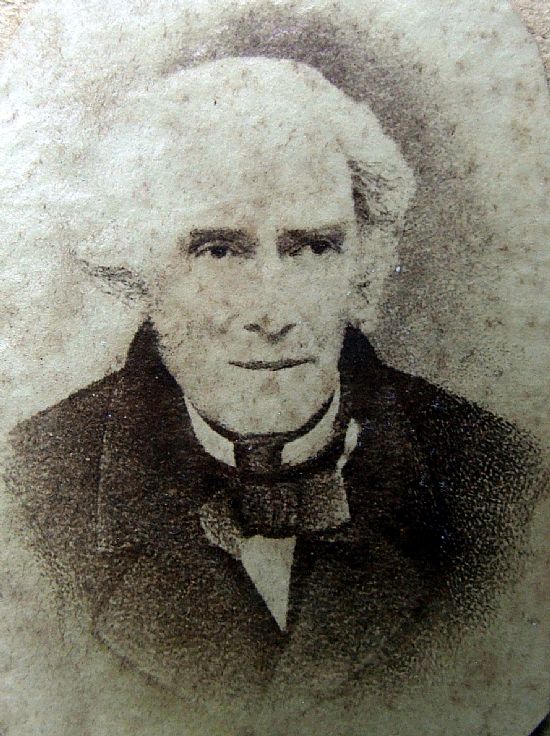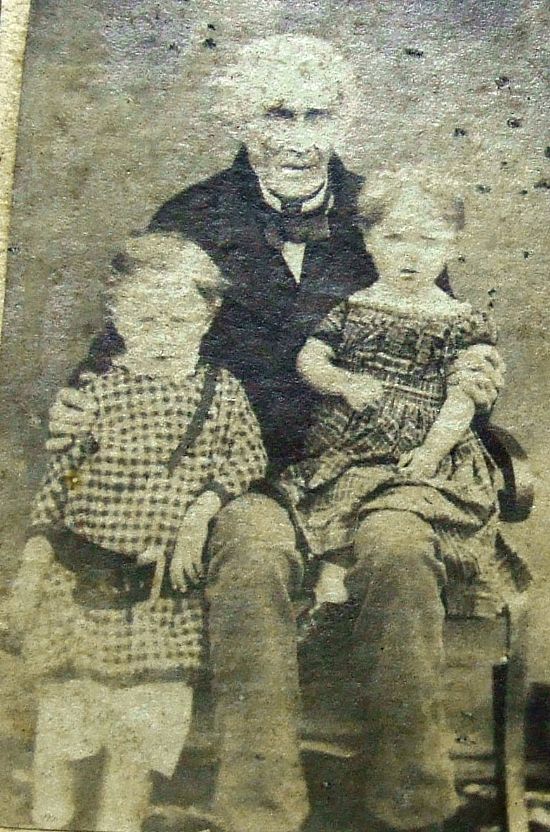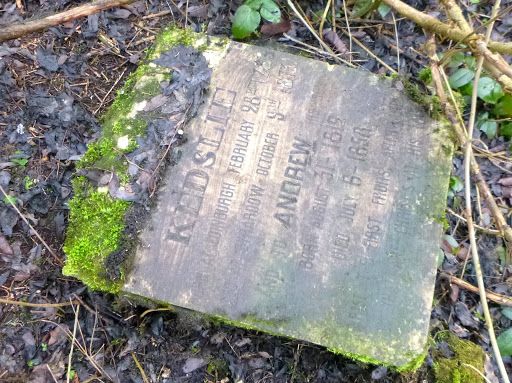Alexander and Agnes Kedslie // Alexander and Catherine Kedslie
TREE ENTRY :
Alexander was the son of Andrew (snr) and Agnes Kedslie. In 1809 he married Catherine Frazer.
15th September 1809.
Kedslie / Alexander Kedslie Merchant Leith and Catherine Frazer resident in Leith Walk and daughter of William Frazer Tailor Edinburgh after proclamation of law were married 15th September 1809.
Leith Walk continues as Albert Place to the south west (changing names several times more along its length) and Constitution Street to the north east (where it runs to the docks). This all suggests that changes have been made to the layout since their time. 
The following is from Geni.com. Note the Polish spelling for Alexander as he spent so much of his life there.
Aleksander Kedslie
Birthdate:circa February 28, 1789
Birthplace:Edinburgh, Edinburgh, Scotland, United Kingdom
Death:October 09, 1873 (80-88)
Å»yrardów, Å»yrardów County, Masovian Voivodeship, Poland
Place of Burial:Wiskitki, Å»yrardów County, Masovian Voivodeship, Poland [See gravestone photo below ].
Immediate Family:
Son of Andrew Kedslie and Anne Clarke
Husband of Jane Fraser [ see my notes]
Father of Catherine Kedslie; Andrew Kedslie; William Kedslie; Alexander Kedslie; Francis Kedslie; Agnes Kedslie; Andrew Kedslie; Adam Kedslie and Jane Kedslie
In the copied record of the family from Scotland's People compiled in February 1823, there is a different spouse name. Yet this certainly appeared to be the correct family. Was this an error in Geni.com OR was he remarried by this time? Are Jane Fraser and Catherine Frazer (note spelling) the same person? Or another family member? Based on the marriage date and names, it appeared that Catherine was the correct person.
The copied record of the family is below. For clarity I have typed it out. This is a record of the children as of February 1823; not so much a birth register, as an update. They were after all born in Poland.

Alexander Kedslie Flour Merchant. Leith. and Catherine Frazer. Sp have children as follow
1._a d.n Catherine born 16 July bap 14 August 1810.
Kedslie 2._a s.n Andrew born 31st August bap 28 September 1812.
Kedslie 3._as.n William Frazer born 22 December 1813 and bap 22 January 1814.
Kedslie 4._as.n Alexander born 22 July bap 21 August 1815.
Kedslie 5._as.n Francis born 15 September bap 10 October 1817.
Kedslie 6._ad.n Agnes. born 25 December 1819 and bap 12 January 1820.
Kedslie 7._as.n Adam Thomson, born 16 December 1821 and bap 14 January 1822.
To which Geni.com has added Andrew and Jane.
(Caution - they have a son also called Alexander Kedslie).
From this point we seem to be on firmer ground.
Agnes Kedslie married Alexander Watson and became my great great grandmother. See more about her in her own section : WATSON, AGNES (nee Kedslie). And this makes Alexander Kedslie and Catherine my great great grandparents.
Below is a photograph of Alexander taken from the album of Poland that I inherited. It is tempting to read into this face, particularly his eyes, all the hopes, trials and hardships of his time there. And below this one is a photo of Alexander with what appears to be his grandchildren.


Mona Kedslie McLeod mentions Alexander Kedslie often. She also has family ties, hence her middle name, and the documents she inherited from her Garvie family have presumably helped significantly with this family research too.
Mcleod notes Alexander's date of birth as 1786 - contrary to that in the Geni.com records, but this is evidently the correct person. She descibes him as a miller. At the time he was born, milling techniques were begining to change. For centuries corn mills had been the property of the landowners and a major source of income. Usually small, water-powered and primitive, using wooden gearing and wheels, they were leased to millers....Both the laird and the millers were entitled to a proportion of the meal ground. As the market expanded, the more ambitious millers moved into or towards the towns. Alongside this was the development of better milling equipment and the use of metal. And from the 1780s the application of steam power was introduced.
The next two maps show "Leith Mills" which predate the mill that Kedslie worked, but are included here to illustrate the development of the area at that time.
Gravestone in Poland

This is the gravestone of both Alexander Kedslie and his son Andrew. It lies scattered with others and overgrown. I found this online while randomly using Google Images to find illustrations. It comes, not from a history or geneaology website, but one on cycling. The name of Alexander is almost hidden, but the photographer identifies it and other details. I am grateful to him for giving permission to use it here. Tomasz Kuran - meteor2017. He wonders : The most interesting gravestone is this one, subtitles in English, Alexander Kedslie, born in Edinburgh, died in Zyrardów. It seems that the Scot - in fact, along with other nations that could be found in Zyrardów, also the Scots were mentioned ... since he came to Zyrk from such a distance, he probably occupied a high position in the factory, who knows maybe he lived in palaces, and the tombstone looks better. And why the grave in Wiskitki, and not in Zyrardów? Because back then there were no churches or cemeteries in Zyrardów.
Alexander Scott Watson had had similar treatment with regard to travel documents and it was presumably a common experience for all immigrants. While they had arrived with very favourable terms, the politics had changed considerably. As Poland was rearranged and became a puppet state of Russia, there was both hindrance and intimidation.
PERSPECTIVE
My New Zealand family contact provides the following which gives better perspective of who is who. Water of Leith and Stockbridge to the west of it were beyond the New Town of Edinburgh (and nwo absorbed by it). Although both families were millers and their eras seemingly concurrent, we need to differentiate between them something that needs further research.
With regards to: Alexander and Jane Kedslie.
Our Agnes m to Alexander Scott Watson bap. 12 Jan. 1805 was actually the sister of Alexander. They were both part of a large family born to Andrew Kedslie and Agnes Thomson all from Stockbridge .
Our Agnes was 70 when she died in Plymouth in 1870.
There was also another Alexander Kedslie married to a Catherine in the same area.
Agnes Stevenson was the daughter of Alison, another sister. The Agnes who kept on working was Alexander's daughter.
Also see : https://www.myheritage.com/names/john_kedslie
POSTCRIPT
In doing research on Scotland's People for this I came across a death register which has the name of a Alexander Kedslie, a child :
5th August 1841.
Alexander Kedslie Son of ? Alexr Kedslie 1yr 7mnths 9 Deanhaugh Street Stockbridge Fever.
What is striking is that of the 25 names on this page (July and August) 18 were children. Reasons for death of these children include Fever for little Alexander to Scarlet Fever, Measles, Dropsy, Decline, Water in the Head and Disease of the Spine.
Deanhaugh Street is now an alley near the Water of Leith and possibly then to do with the mill that Alexander senior was connected with before going to Poland. This gives credence to the suposition that this person was connected to our our known family member. Health condition were directly tied to living conditions. Edinburgh in 1841 was at the point of tremendous improvements, but even if his family was poor and had limited dietry range and quality, simply living in proximity to those with such problems increased the risk of them too.
Bonnington Mill remains : https://en.wikipedia.org/wiki/Bonnington,_Edinburgh ; https://canmore.org.uk/site/148282/edinburgh-newhaven-road-bonnington-mills-granary and https://www.geograph.org.uk/photo/2828367
Graves in Poland: Besides the reference by the person who took the picture of the gravestone depicted above is this reference https://genealodzy.pl/PNphpBB2-printview-t-17451-start-0.phtml Not much detail, but we can note that local people are taking an interest. Wikipedia gives more detail of the cemetry itself and names both Alexander and Andrew. https://pl.m.wikipedia.org/wiki/Cmentarz_protestancki_w_Wiskitkach
NAITONAL LIBRARY OF SCOTLAND : NLS MAPS : https://maps.nls.uk/towns/rec/2713
Kirkwood 1817 : https://maps.nls.uk/view/74400073
THE SCOTTISH WATER MILLS WEBSITE : https://maps.nls.uk/projects/mills/#zoom=16&lat=55.9716&lon=-3.1831
TAYLOR MAXWELL on Bonnington Mill : https://threadinburgh.scot/2022/10/24/the-thread-about-bonnington-its-early-history-where-its-name-comes-from-which-bonnington-house-is-which-and-a-little-bit-of-its-early-industries/
ROY THOMPSON on Bonnington Historical Background : https://blogs.ed.ac.uk/roythompson/wp-content/uploads/sites/566/2024/09/Bonnington_Historical_Notes.pdf

